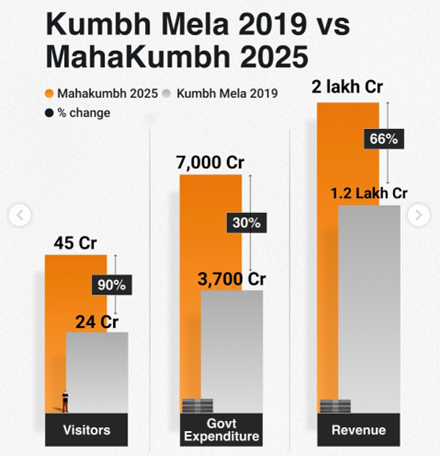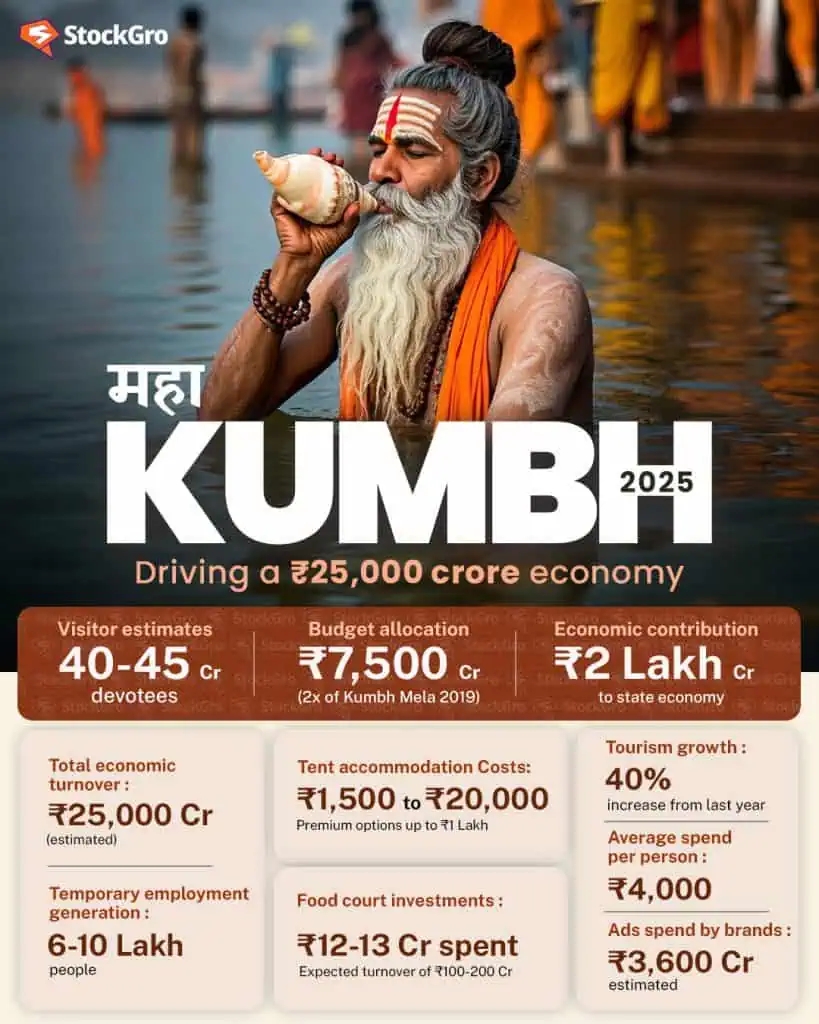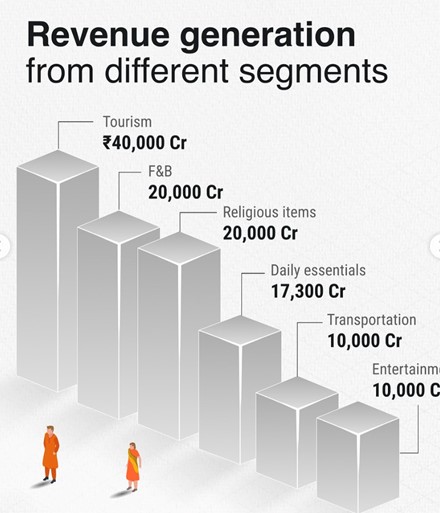Mahakumbh Mela: Where Faith Meets Finance
- P. Varun

- Feb 16
- 4 min read
Updated: May 20
Mahakumbh Mela is a once-in-a-lifetime globally recognised Hindu pilgrimage festival celebrated only once 144 years after the completion of the 12-Kumbh Mela cycle. You've probably been hearing about it constantly these days in the news and on social media. The mela, being held in Prayagraj, attracts 400-500 million devotees, pilgrims and tourists, thus making it the world’s largest peaceful gathering of people.
Mahakumbh is widely recognised for its religious significance, but have you ever taken a step back and wondered how much our government is spending to organise such an event? How much revenue is being generated and from where, and why is such a religiously significant gathering being termed as an “Economic catalyst"? Let us now dive deep and understand the Economic impact of the Mahakumbh Mela on our country and look at the answers to these questions.
Financials Behind Mahakumbh
The financial implications of the Kumbh Mela cycle have always been immense. The Puru Kumbh in 2013 was allocated a budget of ₹1300 crores and saw a total of transactions worth ₹12000 crores. The Ardh Kumbh in 2019 was allocated a budget of 3700 crores and saw a total of transactions worth ₹1.2 lakh crore. The budget for the Maha-Kumbh 2025 is estimated to be about ₹6382- ₹7500 crore, a significant 72% increase in the budget compared to the 2019 Kumbh budget.
Taking into account the average spending for each attendee is around ₹5000 it is been estimated by all Indian traders to generate transactions worth ₹2-2.5 lakh cores, accounting nearly for about 0.8-1% of India’s GDP. Maha-kumbh’s overall revenue generation Is around 60% of the wedding season and Diwali.
The mela is also predicted to have an astonishing turnover of ₹25000 crore. With ₹5000 crores from puja items, ₹4000 crores from dairy products, ₹800 crore from flowers, and almost ₹6000 crore from the hospitality sector and many more.

How is the Budget Spent?
The government has invested highly, and has initiated roughly 549 projects spanning infrastructure development to the sanitation of rivers for the holy bath. Around ₹1428 crores has been invested in hospitality, to complete 83 projects for accommodation of the pilgrims.
They have invested highly in transportation, including airports, roadways and railways to transport the huge influx of tourists across India and the world. Several special trains have been put in place to accommodate the surge of visitors to Prayagraj.
The government has also increased security, surveillance and rescue measures and has spent ₹131 crores on the fire department for better safety, around the area. They have set up numerous toilets, health camps and medical camps and invested significantly in the cleaning of the river.

How is Each Sector Affected?
With surging prices for basic amenities such as food and accommodation due to the massive influx of tourists and pilgrims, Mahakumbh is a “golden opportunity” for various local businesses estimated to generate a year’s worth of revenue in two months.
Let us now see how each sector is reaping the benefits:
Hospitality and tourism: From basic tents to luxurious hotels being booked well in advance and prices ranging from ₹5000-₹1.1 lakh local restraints and transports are set to benefit from high revenues. The hospitality sector is estimated to earn around ₹40,000 crore.
Retail and FMCG: Local businesses, handicrafts and retailers are set to experience an increase in sales due to the high demand for basic amenities and necessities like groceries and milk products driving the revenue. Religious items and clothing are expected to generate ₹20000 crore with additional ₹5000 crore from handicrafts.
Transportation: Railways are running 13000 trains, approximately 7000 roadway vehicles are being deployed, and direct flights from Prayagraj are being introduced from major cities. The overall revenue of the transportation sector is estimated to hit a revenue of ₹10000 crores due to the price surge, reflecting the heightened demand during the mela.
Marketing: Recognising the vast number of pilgrims and tourists attending the mela, numerous brands have leveraged the opportunity to market their products. As you can see below Companies like Sensodyne, Pay Nearby, ENO, etc. have established a strong presence in the mela, providing services, promoting awareness and offering convenience to the pilgrims.
The mela has also become a hotspot for digital media influencers and content creators who, through their online publicity, have attracted more tourists who in turn spend more money and generate revenue.
Several temporary jobs, in security, hospitality, transportation, and sanitation have led to the employment of 45,000 families generating around 6 lakh jobs to ensure the smooth flow of the event.
Government Revenue
We have seen how the budgeted money is being spent, and how different sectors and brands use this opportunity and earn money. But taking into account a key economic metric “return of investment” let us now look into how the government makes money from the mela.
Tax Revenue: All the goods and services sold to tourists and pilgrims during the mela are taxed under GST. The businesses which makes a profit in the sectors discussed above must pay income tax to the government.
Transportation Revenue: Due to providing additional services In railways and roadways, the increased use of public transportation such as Indian Railways and the UPSRTC results in higher revenue for government services. The UPSRTC alone has earned ₹50 crores from additional bus services. Due to increased travel by road from across the country, the government generates a significant amount through the toll gates on the national highways.
Licensing Fees: Temporary vendors and shopkeepers must acquire a permit from the authorities to set up shop during the mela. Due to high demand, the Prayagraj administration has permitted around 50,000 vendors, resulting in a net revenue of ₹25 crores in fees.
International Revenue: Tourists from all over the world attend the Mahakumbh mela, contributing highly to India’s foreign reserves and generating a significant amount of revenue.

Conclusion
The Mahakumbh Mela is one of our time’s most significant religious gatherings, as well as a key economic catalyst. The mela exemplifies the profound interplay between tradition and economic development. It highlights how deeply rooted cultural events can serve as powerful engines for economic activity, fostering growth, employment, and infrastructure development. With careful planning and effective management, Mahakumbh could play a major role in driving our country's economy forward while being celebrated by pilgrims across the world.
- P. Varun



Comments